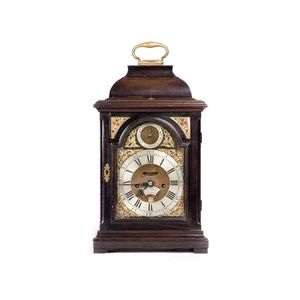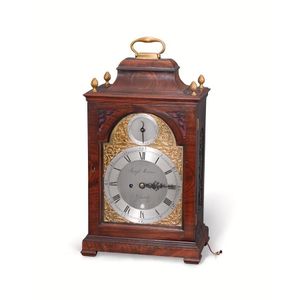John Chalklen Mahogany Bracket Clock
You must be a subscriber, and be logged in to view price and dealer details.
Subscribe Now to view actual auction price for this item
When you subscribe, you have the option of setting the currency in which to display prices to $Au, $US, $NZ or Stg.
- Date Aperture - A date aperture is a cut out section in the face of a watch or clock, displaying the day of the month.
- Mahogany - Mahogany is a dense, close grained red-coloured timber from the West Indies and Central America. It was first imported into Europe in the the early 18th century and its use continued through the 19th century. It was popular for furniture making because of its strength, the wide boards available, the distinctive grain on some boards, termed flame mahogany and the rich warm colour of the timber when it was polished.. The "flame" was produced where a limb grew out from the trunk of the tree, and this timber was usually sliced into veneers for feature panels on doors, backs and cornices.
Some terms used to describe mahogany relate to the country from which it originally came, such as "Cuban" mahogany, "Honduras" mahogany etc. However unless the wood has been tested the names assigned are more a selling feature, rather than a true indication of the timber's origin. - Chapter Ring - A separate metal plate on the face of a clock, on which the numerals for the hours and sometimes parts of the hours, are displayed, usually wheel shaped and sitting on top of the dial plate. The chapter ring is often a feature of the clock and can be silvered or enamelled to stand as a contrast to its background. The hours are usually shown in Roman numerals, although in the late 19th and earlt 20th century, Arabic numerals became fashionable.
This item has been included into following indexes:
Visually similar items

A black lacquered bracket clock, English, 18th century, with a strike and silent dial escapement to the centre of the dial and calendar aperture to the base, brass dial marker 'Ferdinand Vigne, London', 44 cm high, 25 cm wide and 18 cm deep

A George III musical bracket clock, J Thwaites, London, circa 1811, the mahogany brass lined bell top case with rococo finials, each angle mounted with brass herms trailing leafy buds. The sides with brass handles above foliate case sound frets with quarte

A George III mahogany bracket clock, marked Sampson Morrice London, circa 1770 the bell top surmounted by a handle and four urn finials, over scrolling pierced frets, on a stepped plinth base with bracket feet, 7.5 inch two piece silvered dial with Roman a

A fine Scottish George III bracket clock by James Nicoll Canongate Edinburgh, circa 1770. The double fusee bracket clock with verge escapement and pull repeat, housed within a black lacquer case with glazed sides and back, the bell top surmounted with bras
